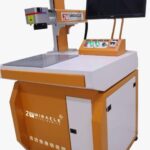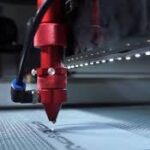Introduction to Laser Engraving
Laser engraving is a precise, non-contact process that uses a focused laser beam to etch or engrave designs, patterns, or text onto a variety of materials. This modern technology is widely used for marking, branding, and personalizing objects in industries such as manufacturing, jewelry, electronics, and more.

How Does Laser Engraving Work?
The laser engraving process involves using a highly concentrated beam of light, controlled by a computer, to burn or vaporize the surface of a material. The laser beam moves across the surface based on a pre-programmed design, leaving a permanent mark without physical contact.
The depth of the engraving depends on the power of the laser and the material being engraved. This process ensures precision and clarity, making it suitable for both intricate patterns and simple text.
Key Features of Laser Engraving
- High Precision: Laser engraving offers exceptional accuracy, allowing for detailed and complex designs.
- Durability: The markings created by laser engraving are long-lasting and resistant to wear.
- Non-Contact Method: As there is no physical contact, the process avoids any damage to the material.
- Versatility: It works on a wide range of materials, including metals, plastics, wood, leather, glass, and ceramics.
- Eco-Friendly: Laser engraving does not use harmful chemicals, making it an environmentally friendly process.

Materials Used in Laser Engraving
Laser engraving is compatible with various materials, including:
- Metals: Stainless steel, aluminum, brass, and titanium.
- Plastics: Acrylic, polycarbonate, and ABS.
- Wood: Hardwood, softwood, and plywood.
- Glass: Decorative glass, wine glasses, and awards.
- Leather: Wallets, belts, and accessories.
- Ceramics: Tiles and decorative pottery.
Applications of Laser Engraving
Laser engraving is utilized across numerous industries, including:
- Jewelry: Personalizing rings, necklaces, and bracelets with names or messages.
- Electronics: Engraving serial numbers, logos, and barcodes on devices.
- Automotive: Marking parts for traceability.
- Manufacturing: Engraving tools, molds, and components for identification.
- Gifting: Customizing gifts such as trophies, plaques, and photo frames.
- Retail: Branding promotional products like pens and keychains.
Advantages of Laser Engraving
- Speed and Efficiency: Laser engraving is a fast process, making it ideal for bulk production.
- Cost-Effective: Minimal maintenance and no need for consumables reduce overall costs.
- Customizability: Easy to adapt designs for specific needs or personalization.
- High Resolution: Perfect for detailed artwork, logos, or tiny fonts.
Challenges in Laser Engraving
- Material Limitations: Some materials, such as highly reflective metals, require specific laser types.
- Initial Cost: The equipment cost can be high, especially for advanced laser machines.
- Skilled Operation: Proper training is required to operate the laser engraving machine effectively.
Types of Laser Engraving Machines
- Fiber Lasers: Best for metals and hard plastics.
- CO2 Lasers: Ideal for organic materials like wood, leather, and acrylic.
- UV Lasers: Suitable for heat-sensitive materials like glass and plastics.
Safety Measures in Laser Engraving
- Protective Eyewear: Operators should wear laser safety glasses to shield their eyes.
- Ventilation: Proper exhaust systems should be in place to remove fumes and debris.
- Enclosures: Machines should have enclosures to prevent accidental exposure to the laser beam.
Laser engraving works with a wide range of materials, including:
- Metals: Stainless steel, aluminum, brass, gold, and silver.
- Plastics: Acrylic, polycarbonate, and ABS.
- Wood: Softwoods and hardwoods.
- Glass: Bottles, mirrors, and windows.
- Leather: Used for personalized products like wallets and belts.
- Ceramics: Tiles, mugs, and decorative items.
- 1. Personalized Gifts
- Laser engraving is popular for customizing items like jewelry, pens, and photo frames. It allows individuals to add names, dates, or messages to make gifts unique.
- 2. Industrial Marking
- Manufacturers use laser engraving to etch serial numbers, barcodes, and logos onto products for identification and branding purposes.
- 3. Signage
- Engraved signs are durable and weather-resistant, making them suitable for indoor and outdoor use.
- 4. Electronics
- Laser engraving is used to label electronic components with tiny, detailed markings that would be difficult to achieve using traditional methods.
Conclusion
Laser engraving is a revolutionary technology that combines precision, speed, and versatility to create permanent and high-quality marks on various materials. Its applications span across industries, from personalization and branding to industrial marking. As technology advances, laser engraving continues to evolve, offering endless possibilities for creativity and innovation.
Let me know if you’d like this article customized further!



